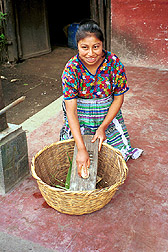This page has been archived and is being provided for reference purposes only. The page is no longer being updated, and therefore, links on the page may be invalid.
|
Read the magazine story to find out more. |
Cooking Process Reduces Toxins in CornBy Linda McGrawAugust 2, 2001 Nixtamalization is not a "sure-to-stump-you" spelling bee word, but a high-temperature, alkaline cooking process that removes toxins produced by the fungus Fusarium moniliforme, which grows on corn. Nixtamalization appears to be the key to reducing the toxins, called fumonisins, that may occur in corn, according to Agricultural Research Service (ARS) chemist Mary Ann Dombrink-Kurtzman. In most years, fumonisins would not present a threat to the U.S. corn crop, but drought stress in some years can trigger fumonisin production. Working at the National Center for Agricultural Utilization Research in Peoria, Ill., Dombrink-Kurtzman reports that nixtamalizing reduces the level of fumonisins in raw corn by almost 80 percent. To conduct these studies, she first had to search for normal-appearing, contaminated corn. Because the incidence of fumonisin-contaminated corn in the United States is low, that search took her nearly a year. Over the past three years, the corn milling industry has voluntarily screened about 2,000 cornmeal samples. Based on the industry's data of low fumonisin levels and knowing that nixtamalizing reduces fumonisins, U.S. corn tortillas might contain between 0.02 and 0.2 parts per million of fumonisins--levels that do not present a problem, according to Dombrink-Kurtzman. This is good news for the U.S. population, which includes immigrant citizens of Central and South America. Corn is a staple food for millions of people in the world and a major source of calories for people in Mexico, Central America, and parts of Africa and China. Other ARS scientists in Athens, Ga., have studied nixtamalization in corn products made in Guatemala. A full report on the nixtamalization process in Guatemala and related work conducted by ARS and a major food company can be found in the August issue of Agricultural Research magazine, ARS' monthly publication. ARS is the chief scientific agency in the U.S. Department of Agriculture. |

